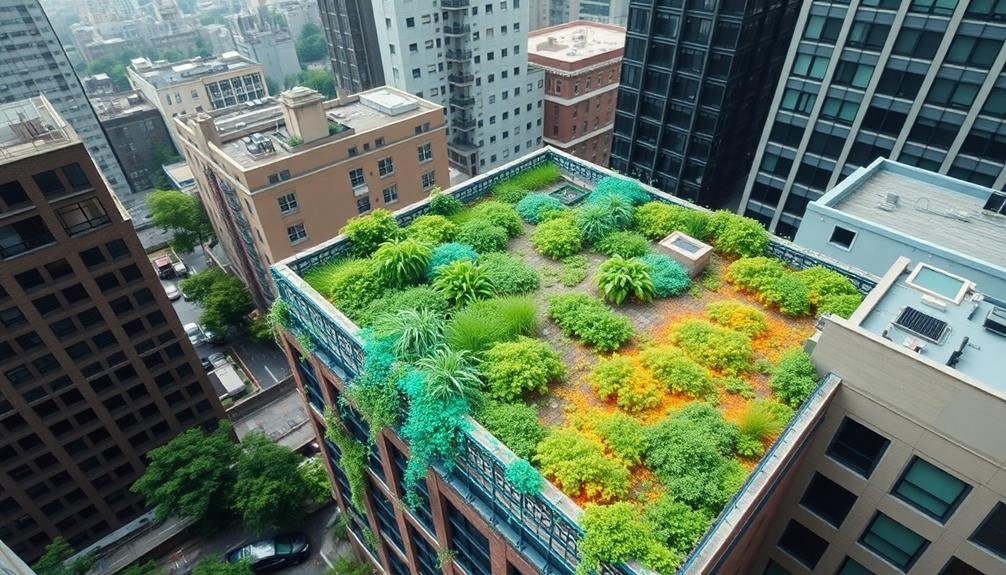Rooftop gardens offer three remarkable cooling benefits for urban environments. First, they combat the urban heat island effect by absorbing sunlight and releasing moisture, reducing surface temperatures by up to 40°F. Second, these green spaces act as natural insulators, lowering air conditioning costs by up to 25% and extending HVAC system lifespans. Third, rooftop gardens improve building insulation, creating barriers that minimize heat transfer and stabilize indoor temperatures year-round. By implementing these green oases, you'll not only enjoy cooler, more comfortable spaces but also reduce energy consumption and utility bills. Discover how these eco-friendly additions can revolutionize your urban landscape and building efficiency.
Reduced Urban Heat Island Effect

In recent years, cities have been grappling with the urban heat island effect, a phenomenon where urban areas experience notably higher temperatures than their rural surroundings. Rooftop gardens offer a promising solution to this problem, helping to reduce the impact of urban heat islands on city dwellers.
When you install a rooftop garden, you're creating a natural cooling system for your building. The plants absorb sunlight and release moisture through transpiration, effectively lowering the ambient temperature. This process can reduce the surface temperature of your roof by up to 30-40°F compared to conventional roofing materials.
As more buildings adopt rooftop gardens, you'll notice a cumulative cooling effect throughout the city. These green spaces help to break up the vast expanses of heat-absorbing concrete and asphalt that contribute to the urban heat island effect.
Lower Air Conditioning Costs
Your wallet will thank you when you install a rooftop garden. By adding this green feature to your building, you'll noticeably reduce your air conditioning costs. The plants and soil on your roof act as natural insulators, preventing heat from penetrating the building's structure. This means your indoor spaces stay cooler naturally, reducing the need for constant air conditioning.
You'll notice a substantial decrease in your energy bills, especially during hot summer months. Studies have shown that rooftop gardens can lower cooling costs by up to 25% in some cases. The savings are even more pronounced in urban areas where temperatures tend to be higher due to the heat island effect.
Moreover, you'll extend the lifespan of your air conditioning system. With less demand on your HVAC equipment, it won't have to work as hard or as often, reducing wear and tear.
This translates to fewer repairs and a longer operational life for your cooling system. By investing in a rooftop garden, you're not only cutting immediate energy costs but also saving on long-term maintenance and replacement expenses for your air conditioning infrastructure.
Improved Building Insulation

Rooftop gardens act as an extra layer of insulation for your building, greatly improving its thermal performance. They create a barrier between your roof and the sun's intense heat, reducing the amount of warmth that penetrates the building's structure. This natural insulation works both ways, keeping your interior cooler in summer and warmer in winter.
The soil and plant layers in your rooftop garden absorb and deflect solar radiation, preventing it from directly heating your roof's surface. This process considerably decreases the heat transfer into your building, reducing the strain on your HVAC system.
Additionally, the air pockets within the soil and between plants act as insulators, further enhancing the garden's thermal benefits.
You'll notice that rooms directly beneath the rooftop garden stay cooler and more comfortable, even during peak summer temperatures. In winter, the garden helps retain indoor heat, reducing energy loss through the roof.
This improved insulation translates to more stable indoor temperatures year-round, creating a more comfortable environment for occupants while simultaneously lowering your energy consumption and utility bills.
Frequently Asked Questions
How Much Does It Cost to Install a Rooftop Garden?
You'll find rooftop garden costs vary widely. They can range from $10 to $25 per square foot for basic installations. However, you're looking at $25 to $50 per square foot for more elaborate designs. Don't forget maintenance expenses too.
Can All Buildings Support the Weight of a Rooftop Garden?
Not all buildings can support a rooftop garden. You'll need to consult a structural engineer to assess your building's load-bearing capacity. They'll determine if reinforcements are necessary. Older structures may require significant upgrades to handle the added weight.
What Types of Plants Are Best Suited for Rooftop Gardens?
You'll want to choose hardy, drought-resistant plants for your rooftop garden. Consider sedums, succulents, and native grasses. They're low-maintenance and can withstand harsh conditions. Don't forget herbs and small vegetables for a practical touch.
How Often Does a Rooftop Garden Need Maintenance?
You'll need to maintain your rooftop garden regularly. Water plants 2-3 times a week, fertilize monthly, and prune as needed. Inspect for pests and drainage issues weekly. Seasonal tasks like replanting and winterizing are also essential.
Are There Any Potential Drawbacks or Risks to Installing Rooftop Gardens?
You'll face potential drawbacks with rooftop gardens. They can increase structural stress, lead to water damage if improperly sealed, and require regular maintenance. There's also a risk of plant debris clogging drains and attracting pests.
In Summary
You've seen how rooftop gardens can help cool your city and your building. They're not just pretty; they're practical too. By reducing the urban heat island effect, you'll enjoy a more comfortable outdoor environment. You'll save money on air conditioning, and your building will stay cooler naturally. With improved insulation, you'll reap benefits year-round. Consider adding a rooftop garden to your building and enjoy these cooling perks.





Leave a Reply